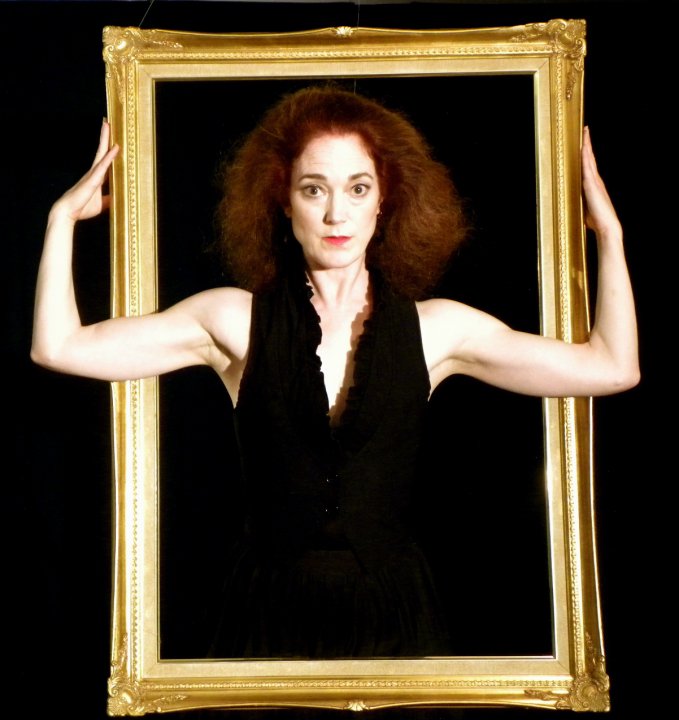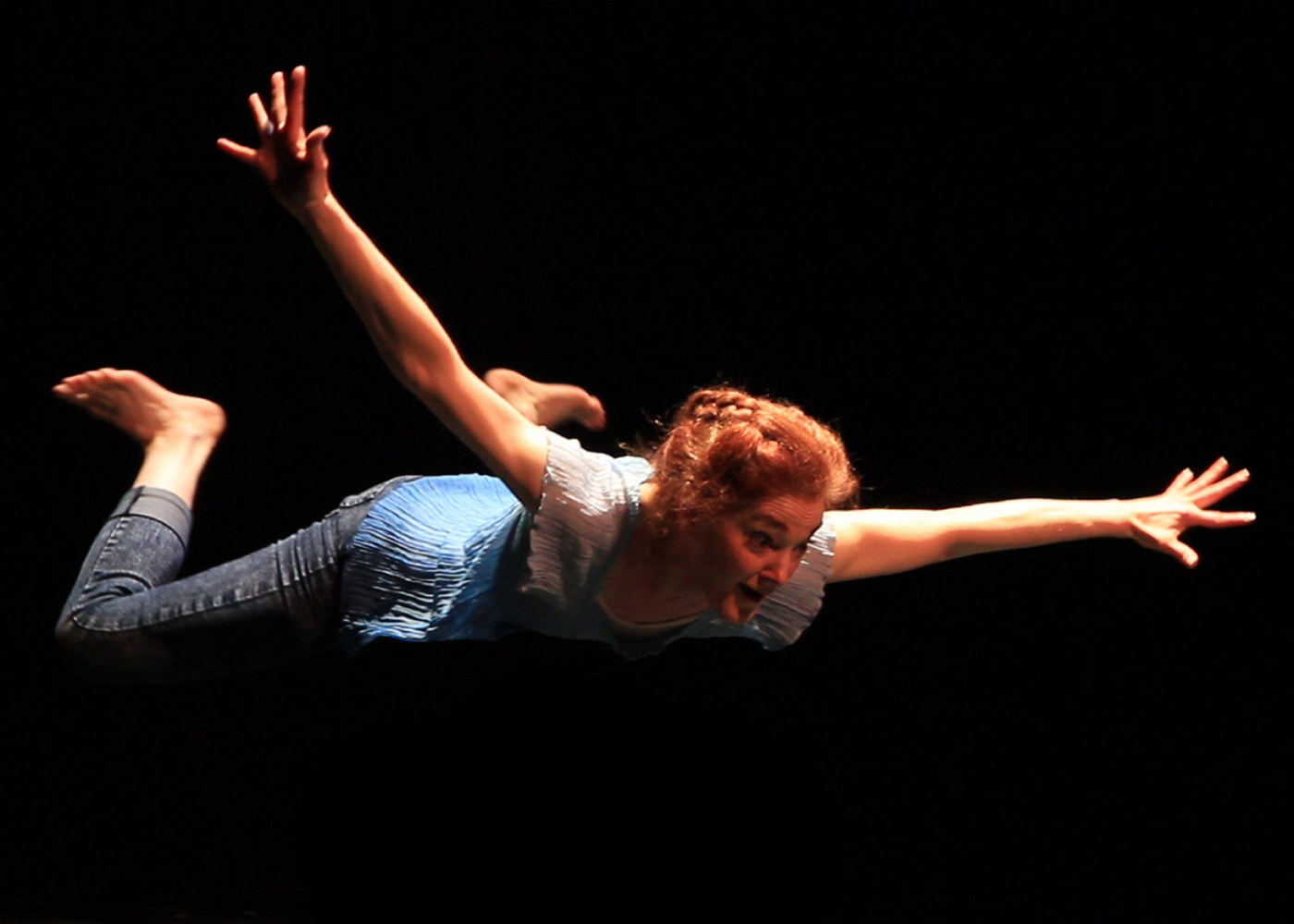

Karen Hurll-Montanaro, Performing Artist, photo courtesy of Christine Sullivan
Karen Montanaro has been performing for 40 years. To say that she knows something about what she's doing is an understatement. She began her career as a classical ballet dancer in her native Maine and then she moved on to perform with the Ohio Ballet and Darmstadt Staatstheater Ballet among others. However, ballet never fully satisfied her as a performing artist. She was continually searching for something more fulfilling.
Along the way, her restless searching brought her into contact with mime artist Tony Montanaro and a whole new world opened up for both of them. They met, fell in love, worked together, created together, and performed together. This is when Karen created the Tanzspiel show which is her main vehicle for artistic expression. In Tanzspiel, Karen fuses mime and dance into a singular and compelling theatrical experience of movement and being.
Tony Montanaro died 10 years ago and left a gaping hole in Karen's life. Her work faltered for a time but did not stop. It was a profound loss and it took time for her to remember why she did what she did. She does it for the love of expression which is at the heart of her one-woman Tanzspiel show. Another important part of her life is sharing her experience as a teacher. What follows is a collection of Karen Montanaro's thoughts on a variety of subjects related to dance, performance and education.
Karen Montanaro's Wonderful World, video by Michael Menes
What are you working on now?
I'm working on my magnum opus, The Journey. I started it a little after Tony died and I'm re-working it now. When I look back now on that whole year after he died, I realize that I was being born all over again. I was in a state of incubation for 15 years with Tony, being infused with everything he knew. Tony and I studied Rumi and mystic Sufism. We were always trying to discover new things together.
What was the inspiration for The Journey?
My inspiration for this piece started with a piece of modern Sufi music. I began with the concept of the still point around which you can rotate and turned myself into the still point. I started this around 11 o'clock at night. I put on this Sufi music and started to undress in mime and I saw that the movements were very interesting.
The music made the movement less literal. Then I saw that a movement like kicking off shoes could be turned into dance. Then it began to turn into a metaphor. I could take men's clothes off and then underneath that I could find a woman's dress. Underneath that I could find a laborer coming home from a hard day of work. Each one takes off his or her clothes differently and I saw the poetry that was possible there.

Karen Montanaro, photo courtesy of Stuart Nudelman
What is the Sufi element?
The Sufi idea is that you will only come to yourself when you strip away everything that is not you. The "you" that you create to get along in the world has to be stripped away. I was doing all of this movement with my pointe shoes on and it came to me that this could all be done with one point, fixed to the floor, around which there exists this struggle to get away.
In the end, this is a metaphor for how we have to be dragged, kicking and screaming, to our freedom. That point of fixation, expressed as the point where my foot is glued to the ground, is going to keep us there until we figure it out. We keep repeating the same patterns over and over until we find out who we are. Auden referred to this as the lucrative patterns of frustration. (This is from Auden's elegiac poem, In Memory of Sigmund Freud.)

Still from Wonderful World, photo courtesy of Michael Menes
How is performing as a solo act different from working in a ballet company?
When you are a soloist you have nothing to hide behind. You've got to find what's compelling. You have to, or you don't eat.
What motivates you when teaching?
Ballet really only grabbed me when I felt like I communicated with myself. It was like communing with my soul. It had nothing to do with being visible or getting approval. I remember doing a waltz turn across the floor by myself for the first time. It was nothing special. It was what you do in ballet but that's when I first felt that perfect feeling of movement and music together. I want kids to have that inner experience that I had: a real communion with themselves.
I think what I'm interested in more than anything else is communication. When I went into a classroom for the first time I wasn't thinking that I wanted to teach kids dance or mime. I just wanted to communicate with them.
What's wrong with how we're teaching children?
What kids learn in school can be good or not. Good can be a relative value or an absolute experience. These are diametrically different. With relative good you are always being taught that you can and should do better and it's always being measured. In this model you are never quite good enough.
The absolute good experience puts people in touch with their true selves and teaches them that their very fact of being is good and sufficient unto itself. Art deals with both elements of good while schools only measure the relative good because it can be quantified. The educational system needs to formulate ways to reach the truth that you can't reach absolute good, you are the absolute good.
When I teach, I want to see the light in your eyes. I want to see you be brilliant because I know that you are in your own unique way. This is what took me to the National Dance Institute.
How did the National Dance Institute affect your approach to teaching?
I think the NDI is God's gift to children. In the last 10 years, in addition to performing, I have been teaching kids from pre-K all the way through high school. I've been through several teacher training courses with NDI and I watch miracles happen every time. And they happen over and over again. I realized that it is repeatable. There's a pedagogy to it.
Along the way I've started to think of dance learning in terms of three things: energy, imagination and focus. These three things need to be equally used otherwise the kids get totally out of balance. It brings me back to myself as a dancer. I had a lot of energy and a lot of focus but not enough imagination. It was totally neglected. The imagination is going into the unformed, the unknown. Children naturally feel that this is their territory. They're in that world all the time. This is the basis of play. What they lack is focus.
Do you have a favorite age group?
The NDI has really aced the third and fourth grade age group and what they can do. I'm convinced that every third and fourth grader should have the NDI experience because at that age, they are capable of so much. As a teacher you have to be a launching pad for the kids, not a crutch.
This age group is in the Age of Visibility. They really want to show you how bright they are. If they don't get the chance to show their inner selves and be fully visible to the world then in fifth, sixth and seventh grades they will gradually begin to withdraw into themselves. It's an absolute feeling of what good is and it can't be measured by any standardized test. The standards of evaluation are all off. In grade school education is all about compliance and then in middle school it turns into conformity.
What is different about the way that NDI teaches this age group?
These kids can memorize random sequences of steps and they can remember surprisingly long chains of choreography. What the teachers do is assign a letter to each shorter sequence of steps. Then the teachers mix them up at random. One group of kids does the sequence as A, B and C, another group does it as D, B and C, and so on. And then they get the kids to dance them all together. They could actually learn the choreography faster than I could so I realized I was going to have to put myself on the line to figure out how they learn.
As I began to learn this new teaching technique I was watching to see how they got the kids to move with such energy, heart and precision. What the teachers do increase the kids performance energy by raising the risk level which gets the children to access higher levels of energy.
How is it different teaching older kids?
When I teach high school I walk into the room and I inform them that they're drones who are barely alive. I tell them that when they were 5 they were fully alive and engaged in the whole world. 5-year-olds see a chair and they climb on it and fully inhabit it with their whole being. And what do we do? We make them sit down. They learn to spell and read and do math but what they really learn is how much of themselves they need to use to get by. Some kids can get all the way through high school using only five percent of their full potential.
Then I explain to them that the problem is that once you get used to only using 5 percent of yourself, you're going to attract jobs, situations and relationships that only utilize that 5 percent and no more. This is not good news and no one talks to them like this.
At this point I locate a girl in the group who looks like she spent a lot of time putting herself together that day and I'll tell her: "that boy who called you for a date yesterday doesn't need you. He only needs that 5 percent of you and he can get that from 95 percent of the other girls in your class. Is that all you want for yourself? What happens to the rest of you?" That's when they get silent and they begin to really think about who and what they are. Kids need real world reasons to work hard.
What's the future for dance education in the schools?
Funding for the teaching I do is getting cut all over. These are challenging times. I will have to be more proactive about promoting myself and not just wait for people to come to me. Finding money is demoralizing. We all use the same words to describe what we do but everyone is so different. It can be hard to differentiate what you do as a teacher from what others are doing.
Why do so many people hate mimes?
I think the main reason mime is held in such low esteem is because there are so many bad ones. They do the rope thing but you can't see the rope. There's no proper technique. It is both the strength and the weakness of mime that it's really very esoteric. When you take archetype and put it together with physical movement you make poetry visible.
Do you feel like Tony left you too soon?
Metaphysically I feel like Tony left exactly when he should have. I don't feel like our relationship is over by any means. There have been many times when I've felt like I knew exactly what he would say at a given moment. I carry his voice in my head.
I went to one theater to perform where I had been with Tony a few times previously. That was back when I was doing my first solo performances and he always helped me to set up and gave me so much moral support. He even announced the show for me.
So I went back to this theater after he died and I was afraid that I would be overcome with grief and not be able to find my purpose in being there. The theater was totally quiet as I began the ritual of setting up my show. The silence was overwhelming. And then this thought came to me in Tony's voice: "Just because everybody thinks I'm dead doesn't mean they're right." He still gives me comfort and he's still with me.
